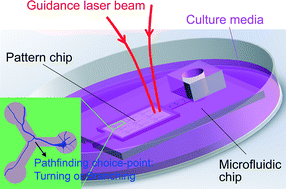Single-neuron axonal pathfinding under geometric guidance: low-dose-methylmercury developmental neurotoxicity test†
Abstract
Because the nervous system is most vulnerable to toxicants during development, there is a crucial need for a highly sensitive developmental-neurotoxicity-test model to detect potential toxicants at low doses. We developed a lab-on-chip wherein single-neuron axonal pathfinding under geometric guidance was created using soft lithography and laser cell-micropatterning techniques. After coating the surface with L1, an axon-specific member of the Ig family of cell adhesion molecules (CAMs), and optimizing microunit geometric parameters, we introduced low-dose methylmercury, a well-known, environmentally significant neurotoxicant, in the shared medium. Its developmental neurotoxicity was evaluated using a novel axonal pathfinding assay including axonal turning and branching rates at turning points in this model. Compared to the conventional neurite-outgrowth assay, this model's detection threshold for low-dose methylmercury was 10-fold more sensitive at comparable exposure durations. These preliminary results support study of developmental effects of known and potential neurotoxicants on axon pathfinding. This novel assay model would be useful to study neuronal disease mechanisms at the single-cell level. To our knowledge, the potential of methylmercury chloride to cause acute in vitro developmental neurotoxicity (DNT) at such a low dosage has not been reported. This is the first DNT test model with high reproducibility to use single-neuron axonal pathfinding under precise geometric guidance.


 Please wait while we load your content...
Please wait while we load your content...